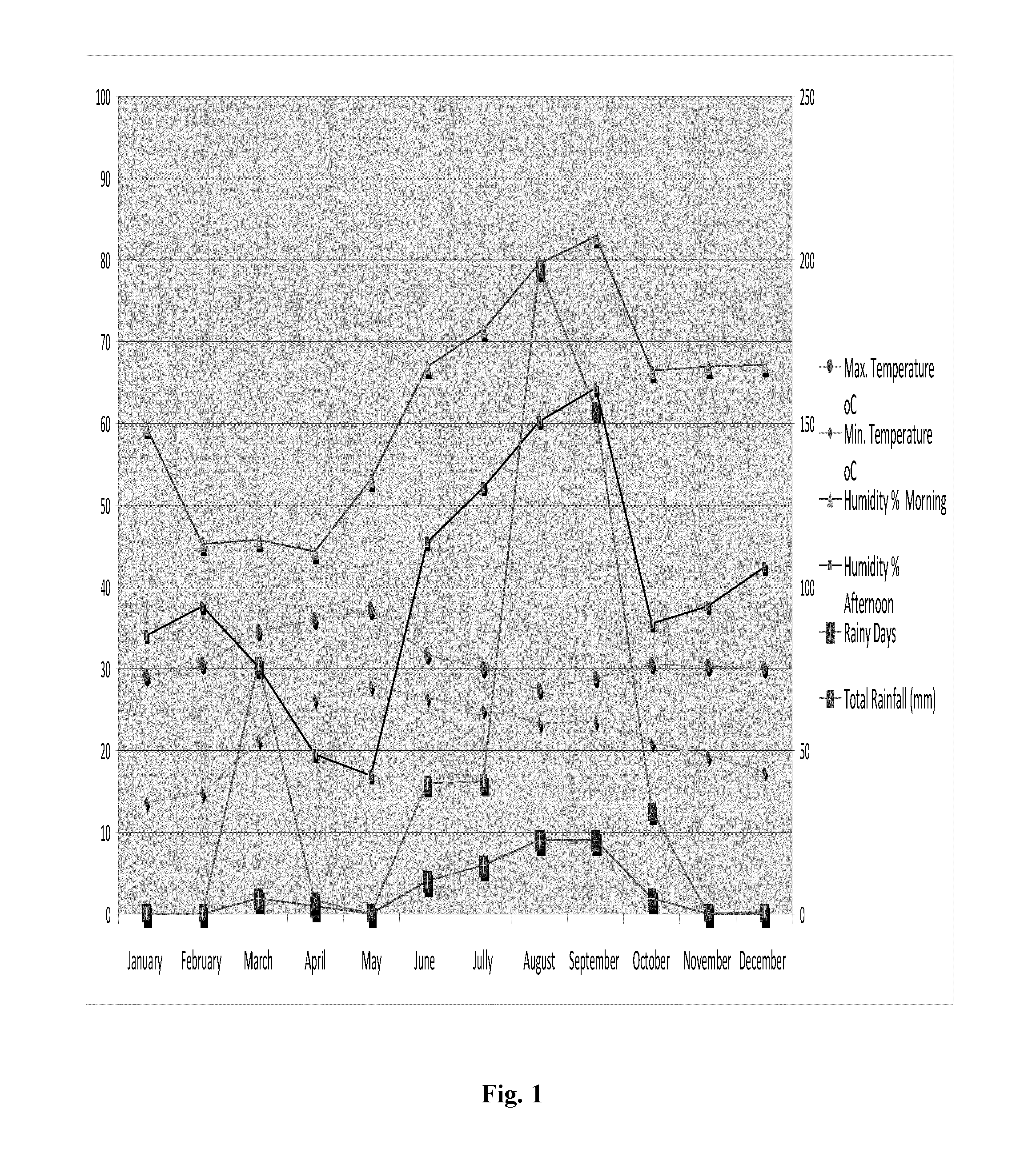Gene conferring tobacco streak virus resistance
- Summary
- Abstract
- Description
- Claims
- Application Information
AI Technical Summary
Benefits of technology
Problems solved by technology
Method used
Image
Examples
example 1
Artificial Inoculation and Methodology for Identifying TSV Resistance in Sunflower
[0119]Maintenance of TSV Culture
[0120]Tobacco streak virus culture was typically maintained on TSV susceptible hybrid sunflower PAC-8699 (Advanta India Limited, Andhra Pradesh, India) and cowpea (Vigna unguiculata var Shifali). TSV infected sunflower leaves were collected from the field. Presence of virus was confirmed by ELISA using protocol AS0615TSV sunflower (DSMZ, Germany). The virus was inoculated on fully expanded 6-7 days old cowpea seedlings with inoculation buffer (0.05M Potassium Phosphate Buffer (pH 7.1) incorporated with 2-mercaptoethanol). The mechanical sap inoculation procedure involved grinding one part of TSV infected cowpea leaf tissue in 9 parts of chilled inoculation buffer. A small pinch of abrasive, such as Celite powder was added, mixed well and then applied to fully expanded leaves of sunflower seedlings. The leaves were allowed to dry. The leaves were washed with distilled wat...
example 2
Introgression of TSV1 Gene into Elite Syngenta Lines
[0135]The wild accession sunflower line containing the TSV1 gene responsible for TSV resistance is H. annuus ANN2121 (obtained from USDA; accession number PI 586818; originally sourced from Montana, USA in September 1991). ANN2121 was crossed with elite Syngenta TSV susceptible sunflower line FR818 at Syngenta Seeds, Saint Sauveur, France. The resultant progeny was crossed with elite TSV susceptible Syngenta sunflower line RW666 to obtain a progeny of line (RW666 / (FR818×ANN2121). The line (RW666 / (FR818×ANN2121) was further crossed with elite Syngenta TSV susceptible sunflower line RW666RM to obtain a progeny of line (RW666RM / / (RW666 / (FR818×ANN2121))). The progeny of line (RW666RM / / (RW666 / (FR818×ANN2121))) was backcrossed 4 times to obtain an F5 generation plant. This F5 plant was designated 0GI1100. This line was tested along with parental and other lines under natural virus pressure at Syngenta Limited, Aurangabad, India in 2003 a...
example 3
Virus Testing of 0GI1100 Alongside Other Syngenta Sunflower Hybrids and Lines in a Polyhouse
[0136]H. annuus var. 0GI1100 was selfed to obtain pure seeds. This was ensured by covering the flower heads with cloth bags before opening and subsequent covering with nylon bags over the cloth bags with the onset of seed setting. F1 progeny having the most desirable agronomic characteristics such as good head size and good growth (VTR-2 and VTL-1) were tested for resistance to TSV by artificial inoculation in a polyhouse (see table 2). The susceptible checks used were PAC-36 and Morden lines. VTL1 and VTR2 were found to have clear resistance to TSV.
TABLE 2Comparing TSV resistance of 0GI1100 progeny against other Syngentasunflower hybrids and lines in a polyhousePedigree / Main reaction onRes. Code No.infected plantsRemarksVTR-2No symptomsResistantVTL-1No symptomsResistant275AXOFT26173-14Paling and stuntingNot clear338AXOFT26173-14Paling and stuntingNot clearLA-27XOFT26173-14PalingNot clearLA-3...
PUM
| Property | Measurement | Unit |
|---|---|---|
| Fraction | aaaaa | aaaaa |
| Volume | aaaaa | aaaaa |
| Volume | aaaaa | aaaaa |
Abstract
Description
Claims
Application Information
 Login to View More
Login to View More - R&D
- Intellectual Property
- Life Sciences
- Materials
- Tech Scout
- Unparalleled Data Quality
- Higher Quality Content
- 60% Fewer Hallucinations
Browse by: Latest US Patents, China's latest patents, Technical Efficacy Thesaurus, Application Domain, Technology Topic, Popular Technical Reports.
© 2025 PatSnap. All rights reserved.Legal|Privacy policy|Modern Slavery Act Transparency Statement|Sitemap|About US| Contact US: help@patsnap.com

